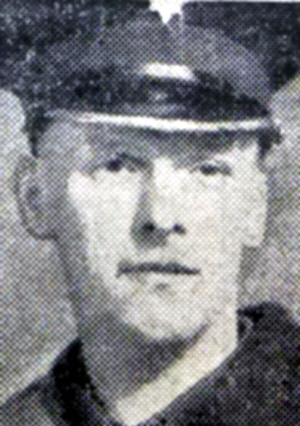
Raymond Elliott was born on the 25th April 1915, the fourth son of six surviving children born to miner William Elliott and Amy Bedford, both of West Ardsley, who married at St Mary’s Church, Woodkirk on the 25th March 1905. In 1911, the couple were living at Hill Top, West Ardsley with their two sons born by that date. The couple had lost another child before April 1911. Raymond Elliott had at least four other siblings: Harry, born 1912; Betty, born 1916; Arthur, born 1919 and Richard Elliott born in 1927.
By 1939, miner William Elliott and his wife, Amy, were living at 6, Hill Top South, West Ardsley, with one of their daughters, Betty and their son Raymond, a leather worker. Raymond married Nellie Grace in Ossett in the early years of 1940 and they had a girl, Marie Elliott, who was born in 1942.
Nellie Grace was born in early 1920, the daughter of Arthur Grace and Annie Thompson, who had married at Holy Innocents’ Church, Thornhill Lees on the 6th April 1912. In 1915 the couple lost a daughter under the age of one year with the same name, Nellie Grace.
The 1st Battalion, Irish Guards had only just arrived in Tunisia, just in time to celebrate St Patrick’s Day in the town of Bone. They arrived at a critical moment, with the Allies attempting to put the final squeeze on the German and Italian forces. They went straight to the front line just as the fighting intensified.
In April 1943, the Allies planned their final assault on Tunis, North Africa, but the massive feature of the Djebel Bou Azoukaz, which dominates all ground east and west between Medjez-el-Bab and Tebourba, blocked the way of the 24th Guards Brigade, which included Elliott’s 1st Battalion, Irish Guards. After two days bitter fighting, with heavy casualties, the 1st Battalion, Irish Guards were still defending the “Bou” against counter-attacks from the German 8th Panzer Regiment troops who were brought into assault their positions. 35 of the Irish Guards, including Corporal Raymond Elliott were killed in the fighting on the 27th April 1943.
The “Ossett Observer” had an obituary for Raymond Elliott:1
“Ossett Soldier Believed Killed – Corporal Raymond Elliott – Mrs. N. Elliott, who lives with her mother, Mrs. Grace, 10 Grove Street, Healey Road, Ossett, received official information that her husband, Corporal Raymond Elliott (28), was reported ‘missing believed killed’, on April 30th. Corporal Elliott was a native of West Ardsley and was educated at Westerton Council School, being afterwards employed at Ingle’s Leather Works, Hunslet, Leeds for nine years. He joined up in June 1940 in the Irish Guards and went to North Africa in February this year. On his marriage between three and four years ago, he went to live in Grove Street, Healey Road. There is one child, a girl, fourteen months old. He was an adherent of St. Mary’s Church, Woodkirk.”
A few weeks later another notice appeared in the “Ossett Observer” confirming his death:
“We announced recently that Corporal Raymond Elliott (28), Irish Guards, of Grove Street, Healey Road, Ossett, had been officially reported ‘missing believed killed.’ His wife, who lives with her mother (Mrs. Grace) and a fourteen-month old girl, has this week received a letter from the O.C. Regimental Headquarters: ‘It is with deep regret I have to inform you that your husband, Corporal Raymond Elliott, was killed in action on April 27th 1943. His body was found and buried by his comrades. Your husband met a gallant end, taking part in a successful attack which undoubtedly went far towards bringing the campaign in North Africa to a triumphant conclusion. I feel and hope you will find comfort in the fact that he gave his life in the service of others. No tribute can be too high for such sacrifice.”
Raymond Elliott died on the 27th April 1943, aged 28 years. He is remembered on Face 13 of the Medjez-el-Bab Memorial in Tunisia. Medjez-el-Bab is approximately 60 kilometres west of Tunis. Medjez-el-Bab War Cemetery, in which the Memorial stands, is situated 5 kilometres west of Medjez-el-Bab on the road to Le Kef.
In May 1943, the war in North Africa came to an end in Tunisia with the defeat of the Axis powers by a combined Allied force. The campaign began on 8 November 1942, when Commonwealth and American troops made a series of landings in Algeria and Morocco. The Germans responded immediately by sending a force from Sicily to northern Tunisia, which checked the Allied advance east in early December. In the south, the Axis forces defeated at El Alamein withdrew into Tunisia along the coast through Libya, pursued by the Allied Eighth Army. By mid April 1943, the combined Axis force was hemmed into a small corner of north-eastern Tunisia and the Allies were grouped for their final offensive.
Medjez-el-Bab was at the limit of the Allied advance in December 1942 and remained on the front line until the decisive Allied advances of April and May 1943.
The Medjez-el-Bab Memorial commemorates almost 2,000 men of the First Army who died during the operations in Algeria and Tunisia between 8 November 1942 and 19 February 1943, and those of the First and Eighth Armies who died in operations in the same areas between 20 February 1943 and 13 May 1943, and who have no known graves.
The memorial stands within Medjez-el-Bab War Cemetery where 2,903 Commonwealth servicemen of the Second World War are buried or commemorated. 385 of the burials are unidentified. Special memorials commemorate three soldiers buried in Tunis (Borgel) Cemetery and one in Youks-les-Bains Cemetery, whose graves are now lost.
The five First World War burials in Medjez-el-Bab War Cemetery were brought in from Tunis (Belvedere) Cemetery or in Carthage (Basilica Karita) Cemetery in 1950.2
References:
1. “Ossett Observer”, Saturday, May 29th 1943 and Saturday, June 12th 1943.